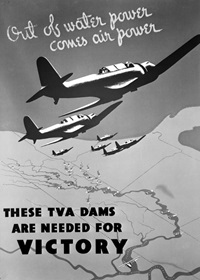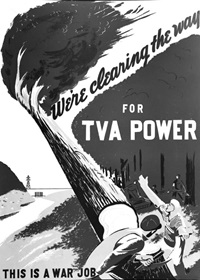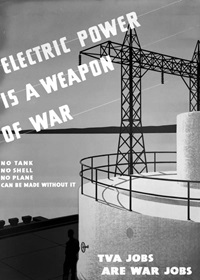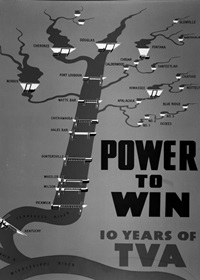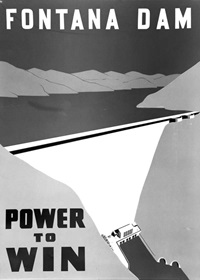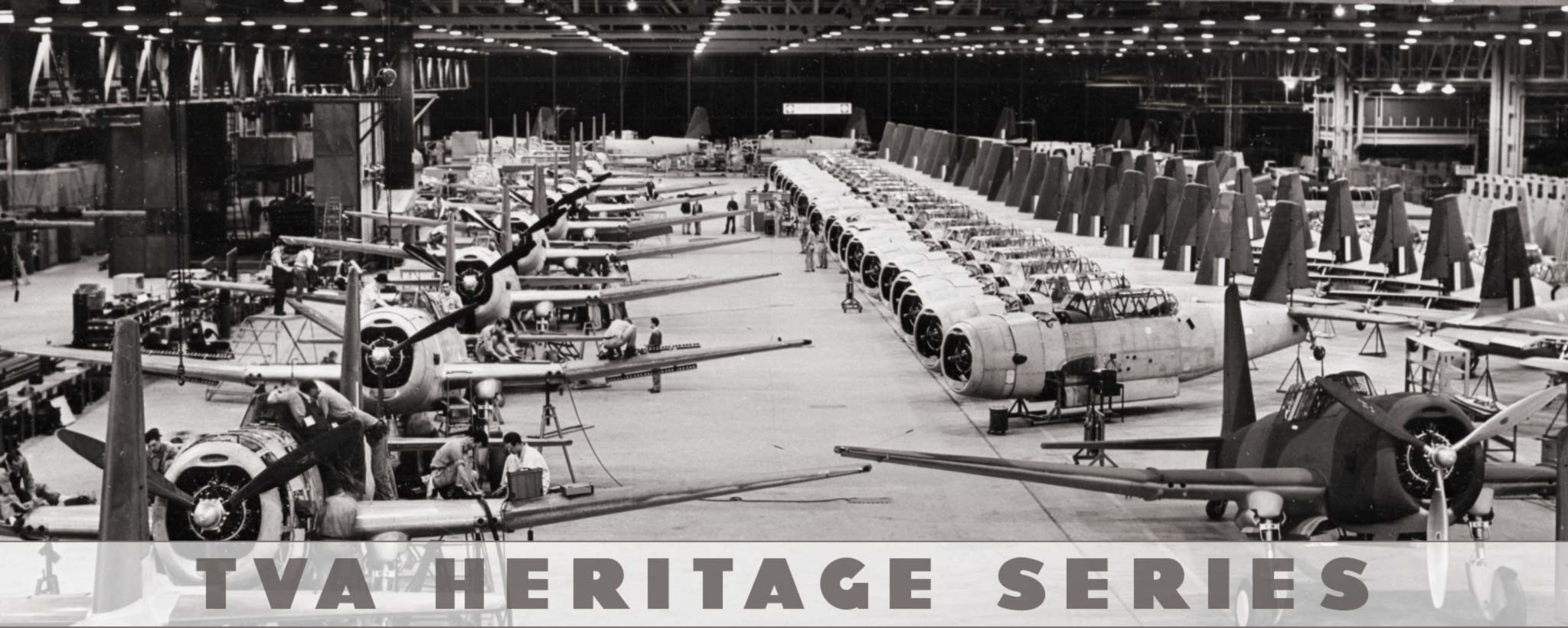
Powering World War II
The thought probably never crossed the minds of Axis war planners, but America’s World War II arsenal included a secret weapon: TVA.
The spring of 1933 brought brand-new beginnings to the Tennessee River valley. TVA was inaugurating a new era of organization and cooperation, one that offered unprecedented freedom from toil and nature’s wrath to thousands across the region.
But at the same time, things were going terribly wrong in other parts of the world. That spring the Nazi regime was born as the German Reichstag gave Adolf Hitler the powers of a dictator. Simultaneously, militarists with plans to seize much of Asia were gaining power in Japan.
It might seem that TVA and the struggle against global totalitarianism had little to do with each other. But the free world would have reason to be thankful that by the time war came, TVA was fully grown and ready to help.
Power Player
TVA’s readiness for war was no accident. As early as 1935, Chairman Arthur Morgan testified before Congress that “an adequate supply of electric energy comes pretty close to being a matter of national defense.”
Over the next six years, TVA took the initiative and geared up its energy capacity to be ready in the event of war. The Federal Power Commission declared later that without TVA, the United States wouldn’t have been prepared to fight in 1941.
TVA made a number of key contributions to the war effort. Its mapping department, based in Chattanooga, Tennessee, used aerial reconnaissance and techniques perfected in the course of mapping the TVA region to make crucial maps of Europe for Allied aviators. Its nitrate plants in Muscle Shoals, Alabama, supplied the raw material for thousands of tons of munitions, as well as fertilizer to help grow food in beleaguered Allied countries.
But TVA’s main contribution lay in producing enormous amounts of electric power.
TVA had many power customers that were vital to the war effort, including an A-31 bomber factory in Nashville (pictured at top of page). But two customers loomed larger than the others. One had been in the region long before TVA was; the other came to the region, in large part, because TVA was already here.
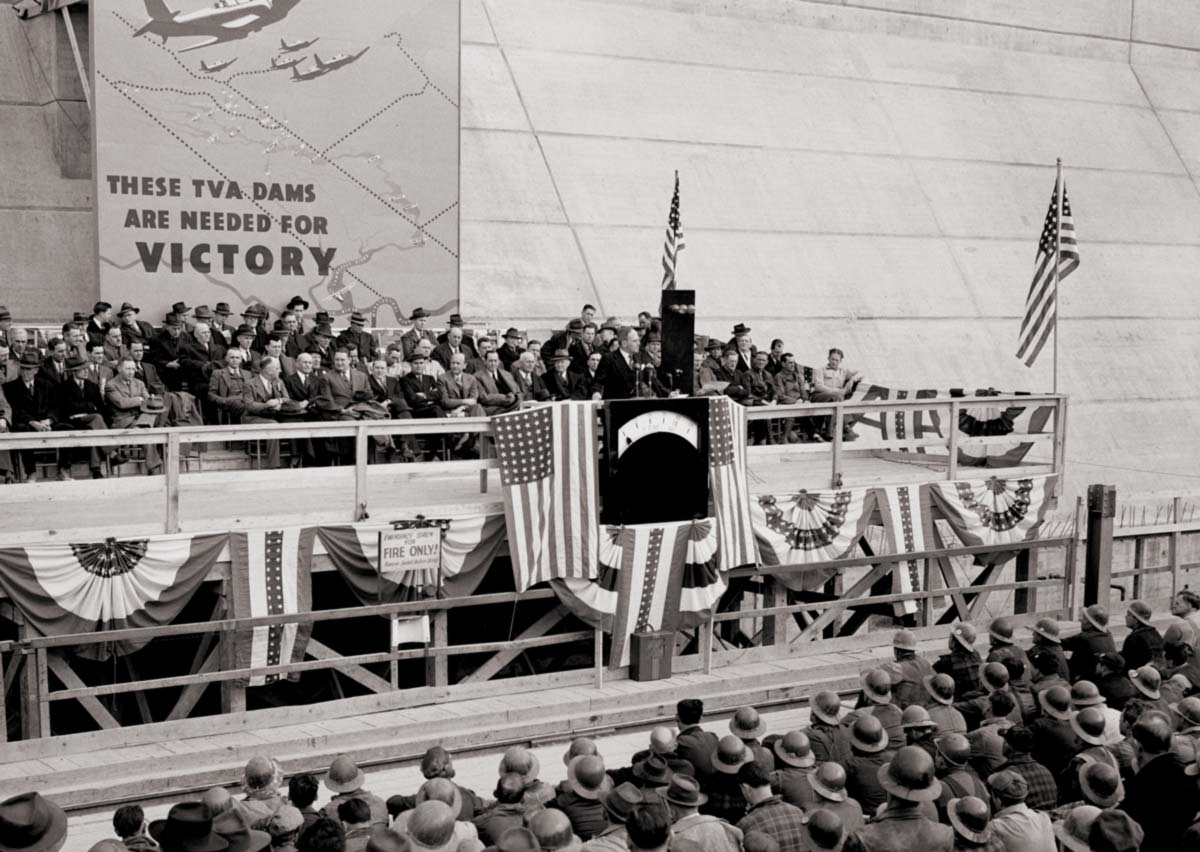
Essential Aluminum
The first was Alcoa. The Aluminum Company of America’s factory south of Knoxville, Tennessee, was then the largest aluminum plant in the world. Months before Pearl Harbor, as war loomed, defense experts realized how important aluminum would be in building an air force—especially one with the 50,000 plane-strength demanded by President Roosevelt in May 1940.
In its early days Alcoa had produced its own energy, partly from hydroelectric plants of its own. But it had started buying TVA power in 1935, forming an unusually close public-private relationship with its supplier.
In 1941 Alcoa made the government a gift of its Fontana property—a prime site for a TVA dam—in return for various considerations from TVA. A bill authorizing the construction of Fontana Dam was signed 10 days before Pearl Harbor.
TVA launched the crash construction of two more dams, Cherokee and Douglas, largely to support the wartime production of aluminum. Cherokee was completed in just 16 months, a full year ahead of schedule. Douglas went up in 12 months and 17 days.
The country’s preoccupation with aluminum during World War II might seem surprising to people unfamiliar with the business side of war. But according to a 1946 article in Fortune magazine, what won the war was air power, based on “aluminum and Alcoa.”
Secret Project
The second of TVA’s critically important wartime power customers was a secret project set up in an isolated area along the Clinch River in 1942. At first it was known simply as the Clinton Engineer Works, after the nearest town of any size, Clinton, Tennessee. It was part of a larger effort code-named the Manhattan Project—the program that produced the first atomic bomb.
To manufacture the nuclear materials needed for the bomb, the government secretly built an entire city called Oak Ridge in the hills of Tennessee. The location was chosen for a number of reasons, but two of them were directly related to TVA’s presence.
One, of course, was the massive amount of power needed to fuel the elements of nuclear-materials production: the centrifuge and the electromagnetic and gaseous-diffusion processes.
The second arose from the fact that nuclear-materials production, delicate and potentially dangerous, required plenty of fresh water for cooling—and fresh water in a place planners were confident would never, ever flood. Looking across most of the country, that seemed a tall order. But Oak Ridge, 16 miles downstream on the Clinch from TVA’s Norris Dam, could fill the bill.
For three years the Clinton Engineer Works churned away, using millions of kilowatts of TVA energy for something not even the Chairman of TVA knew about—until August 1945, when the bombs dropped on Hiroshima and Nagasaki ended the war.
If at this critical juncture TVA helped change history, its work during the war changed TVA as well. According to some historians, it was World War II more than anything else that focused TVA’s efforts on energy production.
And the contributions TVA made from 1941 to 1945 also had the effect of cementing its national reputation. For all its accomplishments before and since, TVA’s star may never have shone brighter than when it helped win America’s biggest war.
